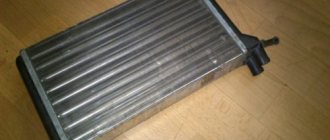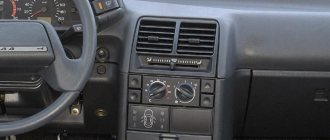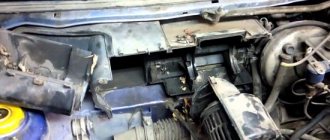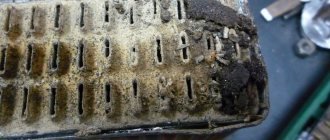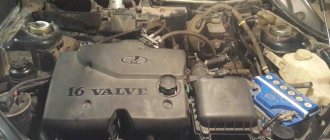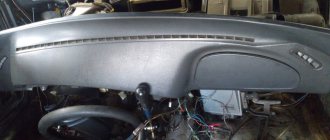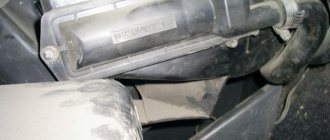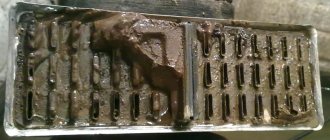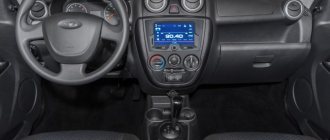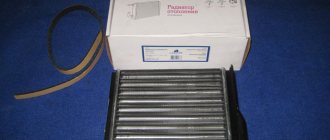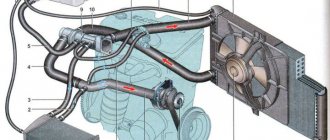Heating system
The stove and bypass valve, integrated into the cooling system of the machine, are the main heating elements. The heater radiator is heated due to the high temperature of the engine coolant, which also enters the heat exchanger.
So if the pump is in order, the thermostat is working, the heater fan is not burned out, the air ducts are not clogged, the antifreeze level is normal and there is no air lock in the cooling system, then the cause of poor heating is contamination of the heater radiator.
This happens because all the dirt traveling through the system ends up in the heater radiator, gradually clogging its cells. Over time, this leads to a decrease in the temperature of the air entering the vehicle interior.
There are two ways to clean the heat exchanger: flushing the stove radiator without removing it from the car, and the same procedure, completely dismantling it.
Procedure
First of all, you need to drain the antifreeze. To avoid wasting this valuable substance, we strongly recommend that you drain it carefully. To do this, you can use any convenient container: a bucket, an empty plastic bottle, etc. After removing the protective shield, unscrew the cap on the radiator, first replacing the container. Antifreeze can drain quite slowly, so be patient. To adjust the intensity, you can use the plug closing the expansion tank.
Then you can start working directly with our “magic” solution. After pouring diluted citric acid into the cooling system, add a little water according to the level. The following is what needs to be done:
- start the car, warm up the engine a little (to about 50 degrees);
- in neutral gear, increase the gas (up to approximately 3 thousand revolutions), let the engine run in this mode for some time (8-10 minutes is enough to warm up to 100 degrees);
During such warming up, a good “running” of the cooling system is ensured. After 10 minutes, turn off the engine and let it sit for a while. After a break, starting the car again, a sharp increase in engine temperature will be noticeable. This indicates that the liquid in the cooling system is no longer circulating. You should immediately turn off the engine and then carefully remove the throttle body hose. This will ensure free flow of gas.
Further interaction with the machine will be cyclical: warming up and removing the hose. After about an hour, you can safely drain the liquid (rinsing solution with citric acid), while rinsing the cooling system several times with plain water. 4-5 washes are enough to achieve a good result (the dark color of the water should completely disappear).
Washing without dismantling
The first and most easily accessible method is to flush the radiator without resorting to any disassembly of the system.
We make a solution of citric acid and distilled water based on the proportion of 100 grams of lemon juice for the entire volume of the cooling system of your car. Drain out the old antifreeze and fill in the solution. Then we drive it for 5-6 days. After this period, drain the liquid, along with which all dissolved dirt and scale will come out. We fill in new antifreeze and enjoy the warmth in the cabin.
The second method requires a little preparation and minor disassembly of the components of the car's heating system.
For this procedure you will need:
- Compressor or water pump.
- A pair of hoses with adapters. One end of which corresponds to the diameter of the hoses coming out of the stove.
- Clamps, container for flushing liquid, fume tape.
- A product that will be used to flush the heat exchanger.
The products that are used to clean the heater radiator are worth covering in more detail. In the selection of such substances, you need to proceed from what material the heat exchanger is made of. If the radiator is aluminum, then it is unacceptable to wash it with alkaline solutions; in this case, products with a certain percentage of acid in their composition are suitable. When flushing a copper-brass heat exchanger, everything should be exactly the opposite.
For the washing procedure, you can use professional products, such as special Mannol liquid, or improvised means.
In choosing available liquids, advice varies; for some, Xylitol or Antiscale has become a panacea for descaling household coffee makers and kettles; others advise using regular Coca-Cola or whey; others praise Krot for cleaning pipes.
But it is better to use a proven method - washing with citric acid, and if the heater is copper - with caustic soda.
TOP 3 best liquids for flushing the cooling system
LAVR Radiator Flush
LAVR Radiator Flush Classic . LAVR is a Russian brand of auto chemical goods. LAVR Radiator Flush Classic is an excellent solution for flushing the cooling system of any car. Product catalog number is LN1103. The approximate cost of a 0.43 liter package is $3.5, and a 0.98 liter package is $5.10.
A 430 ml bottle will be enough for you to use in a cooling system with a total volume of 8.10 liters. The composition is poured into the system and topped up with warm water to the MIN mark. After this, the engine should run for about 30 minutes at idle speed. Next, the product is removed from the system and washed with distilled water for 10.15 minutes with the engine running at idle. After this, you can fill in new antifreeze.
The useful properties of the product include an increase in the service life of antifreeze by 30.40%, effective removal of scale, antifreeze decomposition products, rust, and dirt. Contains a corrosion inhibitor, increases the life of the pump and thermostat.
| Positive feedback | Negative reviews |
| I simply used the Laurel wash because literally shortly before I had just used a ring decarbonizer under the same name, I saw the result, so I decided not to tempt fate and use a product from the same company. | No negative reviews found. |
| At one time I also used Laurel on a VAZ-21099. The impressions are only positive. But I also did washings every two years. So I never had dirt in the cooling system. | . |
7-Minute Hi-Gear Radiator Flush
Hi-Gear Radiator Flush - 7 minutes . Manufactured in the USA by Hi-Gear. Sold in the CIS countries, as well as Europe and America. Hi-Gear cooling system flushing is a very popular remedy among motorists all over the world. Article: HG9014. The price of one 325 ml can is about $4.6.
A 325 ml can will be enough for you to flush a cooling system with a volume of up to 17 liters. The product can be used to clean cooling systems of cars and trucks. A distinctive feature is the short operating time, namely 7 minutes .
The useful properties of the product include the fact that it increases the efficiency of the radiator by 50.70%, eliminates overheating of the cylinder walls, restores coolant circulation, reduces the likelihood of engine overheating, and protects the pump seal. The product does not contain acids, does not require neutralization, and is not aggressive to plastic and rubber parts.
| Positive feedback | Negative reviews |
| I have been using Hi-Gear (USA) flushing products from this company since I purchased my first car, I have never had any complaints, especially with “injector cleaners” | I liked the Hadov washing system better + it’s cheaper. |
| After the cheap wash it didn't get any better, but high gear helped | . |
Let's start the washing process
To begin with, by lifting the hood, we find two hoses that provide supply and drainage of fluid to the stove. Then:
- in the radiator fins. Having disconnected these hoses, we extend them, securing the joints with clamps and wrapping them with fum tape for tightness.
- Turning on the compressor, blow out the old antifreeze from the heat exchanger.
- Fill the radiator with diluted citric acid or another selected cleaning liquid, give it time, up to half an hour, to dissolve dirt and deposits. In more advanced cases, this time can be increased to several hours. Some people advise that before pouring, for greater effect, heat the solution to the operating temperature of the antifreeze, and in the case of using Coca-Cola, generally boil it.
- After the selected period of time, drain the liquid into a prepared container.
- This procedure must be repeated until no clear liquid comes out of the drain hose.
- By connecting the pump to one of the hoses, rinse the stove under pressure with clean water.
- By connecting the hoses back and adding antifreeze, you need to eliminate air in the system.
As an additional way to influence internal contaminants, some experts suggest connecting a pump to one of the hoses and lowering it into a bucket that serves as a container for draining liquid, driving the cleaning solution inside the stove in different directions. In order to evenly press all passages in the radiator plates.
How to clean the cooling system with citric acid
If we talk about the washing procedure itself, then you should prepare water, citric acid, and also reserve time. The process is not complicated, however, it may well be labor-intensive.
- Please note that to prepare the rinse, you need to use distilled water, not running water. As a last resort, ordinary tap water needs to be boiled well, and only then mixed with acid and poured into the cooling system.
- To effectively mix water and acid, you need to take about 0.5 liters of water in a separate container, then this water should be boiled. After the water begins to boil, add citric acid. This allows the acid to dissolve well. Next, the resulting solution is cooled. After this, you can pour the prepared solution into the main volume of water, then mix again.
- Next, antifreeze or antifreeze can be drained from the cooling system, assessing the degree of contamination and condition by appearance (color, smell, impurities, etc.). If antifreeze or antifreeze is very dirty, then the water-acid solution should be saturated (about 80 g of acid per 5 liters of water). If the antifreeze is relatively pure, then 40-50g will be enough.
- Now, instead of antifreeze, flushing is poured into the expansion tank, the engine needs to be started and warmed up to operating temperatures at idle (until the thermostat opens and the cooling fan turns on).
- Usually, the engine runs for about 10-15 minutes to clean it, and you can also idle it further. When finished, the engine must be turned off.
- After the internal combustion engine has cooled slightly (15-20 minutes), the solution can be drained. At the same time, its color, condition, etc. should be assessed. If dirt is visible, then the flushing procedure must be repeated by pouring a fresh portion of cleaner into the system.
- A sign that the system has been cleaned will be a clean flush that is drained. Next, you should rinse the system 2-4 more times with distilled water, but without acid. Now you can add fresh antifreeze or antifreeze.
Washing with dismantling
Complete dismantling of the heat exchanger is a troublesome and time-consuming task, but this method makes it possible to clean it not only from the inside, but also from the outside. This method is also better because it can be diagnosed in case of leaks, which can be eliminated by argon welding.
If you still decide to dismantle it, then to gain access to the stove you will have to unscrew the dashboard.
This disassembly is similar to what is required to remove the evaporator when cleaning the air conditioner.
After removing the torpedo you need to:
- Disconnect the pipes leading to the heating unit. In some brands of cars, the heating unit contains an evaporator of the air conditioning system, which means that in order to dismantle the stove, these pipes will also have to be disconnected.
- Carefully unscrew the heating unit and remove it from the interior.
Flushing the stove radiator in this way is made several times easier, because it can be done at home, under hot running water. And even if the chemical ingredients do not help, you can solder the heat exchanger and clean it manually using a brush or similar improvised means in the form of a drill with a long drill bit.
Bad advice
If you type in the line “how to clean the aluminum radiator of a car heater” in an Internet search engine, you will be bombarded with a wave of optimistic advice. At the same time, along with truly adequate proposals, there are many provocative recommendations on the topic of how to quickly “ruin” this node.
At the same time, some recommended products (citric acid, food vinegar) can still be used as a last resort, observing a reasonable proportion. So, a solution of citric acid is made at the rate of 200 - 250 g of powder per 10 liters, table vinegar is diluted in the amount of 500 ml per bucket of water.
Fans of soft drinks Coca-Cola, Fanta and others like them forget that these liquids have a pronounced acid reaction and also contain sugar, which can be deposited in the system. Does it make sense to use household cleaning products such as Domestos, Komet, Krot to flush the radiator when flushing liquids are produced specifically for internal combustion engine cooling systems? The savings in this case do not justify the possible harm.
Useful tips
After cleaning the heat exchanger, do not be lazy to replace the underwater hoses and install new clamps. After all, it will be very disappointing when, after a few days, the cabin becomes cold again, and the culprit is a small hole in the hose or a loose clamp that leads to air getting into the heater radiator.
Periodically clear the air ducts of leaves and dirt that could reduce the heating efficiency.
Use high-quality coolant to prevent re-contamination of the heater with impurities found in low-quality antifreeze.
Periodically turn on the fan at maximum speed to blow through the outer fins of the radiator.
With the onset of cold weather, car owners often find that their car's interior heating system is not working efficiently. Everything seems to be fine, but the air coming from the deflectors is not warm enough. This problem may be an indication that the car’s heater core is clogged and cannot pass the required amount of heated coolant through it.
What to do in such a situation: replace the heater or try to repair it? Do not rush to resort to radical measures. If the heat exchanger does not leak, it can be repaired.
In this article we will talk about how to flush the heater radiator without removing it from the car. In addition, we will discuss which products are best suited for this procedure.
What can I use to wash it with?
There is now a wide range of cleaning products available. The most accessible of these is water. However, it is also the least suitable remedy. Due to the salts present in the water in a dissolved state, scale may form after washing, which in the future will cause contamination and repeated cleaning. For this reason, you should use only distilled or, as a last resort, boiled water.
Special cleaning fluids
The range of cleaning liquids of various compositions and concentrations is quite extensive. Most of them allow you to efficiently clean the engine cooling system. But the choice of product should also be taken seriously, since different types of dirt require substances of different compositions to remove.
Cleaning products can be divided into 4 categories:
- Neutral - do not contain aggressive components, are less effective in cleaning the cooling system than other liquids, and are most often used for preventive purposes.
- Acidic - almost never found in pure form due to their extreme aggressiveness to system parts. Acidic flushing fluids are well suited for neutralizing scale and inorganic deposits.
- Alkaline - like the previous category of substances, are not found in an undiluted state. Effectively removes organic contaminants.
- Two-component - contain both acid and alkali. They are consistently poured into the system and thoroughly clean it of all types of contamination.
Coolant racks
It is better not to use two different products at the same time, since the acid and alkali are neutralized during interaction, which may not only not bring the expected result, but also cause a malfunction. You should also not use substances with high concentrations of acids or alkalis, as they can damage rubber and plastic parts.
Lemon acid
One of the popular “improvised” cleaning agents is a solution of citric acid. If the correct proportions are observed, it copes well with scale inside the radiator and does not damage rubber components. The optimal ratio is 100 g of acid per 1 liter of water.
Citric acid can be replaced with whey. It contains a concentration of lactic acid sufficient for effective and gentle cleaning. Also, flushing with serum is more gentle on non-metallic parts of the radiator.
As is the case with compositions specifically designed for cleaning, it is better to carry out the process itself in several short steps - this will help to avoid breaking off large pieces of scale.
Cleaning OS with serum
"Coca-Cola" and the consequences of such washing
Another common cleaning product. The orthophosphoric acid contained in the drink effectively removes scale from internal parts
However, this product should be used with caution, because in addition to the aforementioned acid, Coca-Cola also contains sugar, which can clog the system. Therefore, after using Coca-Cola, it is necessary to re-clean the system with water to remove any remaining sugar.
The concentration of phosphoric acid has a negative effect on rubber and parts.
Another disadvantage of Coca-Cola as a cleaning liquid is its gas content. Gas expansion due to heating during engine operation can lead to negative consequences for the vehicle. Therefore, if you nevertheless decide to use Coca-Cola as a cleaning liquid or do not have the opportunity to use more suitable substances, you need to get rid of the gas it contains.
Coca-Cola for flushing the cooling system
Keeping the engine cooling system clean is one of the important factors in the health of the car. For this, a wide range of specialized cleaning liquids are available, which, if chosen correctly, will help maintain the optimal condition of this system, as well as all sorts of available alternatives.
But when using the latter, you should be careful and resort to them in the absence of more suitable substances
Why does the radiator clog?
In modern cars, two types of heater radiators are used: copper-brass and aluminum. Each has its own advantages and disadvantages, but they are all susceptible to oxidation and corrosion. Over time, the channels of any radiator lose their capacity due to deposits on the internal walls. This process can also be speeded up by:
- poor quality coolant;
- the use of coolants of different compositions;
- the entry of various debris or active substances, such as oil or gasoline, into the system.
Why does the radiator get clogged?
The reason for poor quality work may be:
- If the car is driven most of the time in cold conditions with the heater running. Accordingly, the radiator channels gradually become clogged with dirt.
- Low quality products are used as a coolant. As a result, the metal radiator begins to oxidize and reaction products clog the heater cells.
- Using ordinary water with a high salt content as a remedy.
- Entry of foreign substances into the cooling system (fuel, oils, chemicals).
Cleaning the system involves removing dirt by washing it using various means: water, special means for flushing the radiator.
How to deal with it
The easiest way to get rid of this problem is to flush the stove radiator. Its essence is to drive a special agent through it that can dissolve and wash away all the scale and dirt. There are two cleaning methods: flushing the heater radiator without removing it from the car and with removal. The first method does not involve dismantling the heater. It is enough to simply disconnect it from the cooling system. In the second case, the heat exchanger is dismantled, and the entire procedure can be successfully carried out even in the bathroom. We will focus on the first option, since flushing the stove radiator without removing it is much easier. And considering that in some cars it is not so easy to get to the heater, it is also faster.
Why does the heater radiator become clogged?
It is clear that a clogged radiator is not a normal phenomenon for a car and this phenomenon has a completely understandable reason. The thing is that during inactivity in the summer, the inner walls of the radiator tubes are subject to increased oxidation, since there is no circulation of liquid in the stove. The oxidation product settles on the walls and covers their entire area, while having the lowest thermal transfer coefficient. As a result, the copper or aluminum radiator tubes do not heat up and the heater blows cold air.
All these problems can be resolved using three different methods:
- Replace the heater radiator with a new one. An elementary way to get rid of many problems at once, but not the most economical, since the price of a new radiator is quite high.
- Wash the radiator after removing it from the car. This method is not associated with the cost of new spare parts and allows you to achieve maximum effect. However, it has one significant drawback - high labor intensity. Removing the heater radiator from the car panel is quite difficult.
- Flushing the radiator without removing it. The most economical and fastest option. Allows you to return the stove radiator to a working position without removing it. This is the method we will look at below.
Effective stove cleaning products
Now let’s figure out how to effectively flush the radiator channels. Plain water, you will agree, is unlikely to do. Flushing the stove radiator involves pouring into it agents that can destroy the scale that has formed and deposited on the walls. These means can be:
- special liquids for flushing the cooling system (factory-made);
- household products for cleaning sewer pipes and removing scale (“Mole”, “Komet”, “Tiret”, “Kalgon”, etc.);
- acid solutions (citric, acetic acid);
- alkaline solutions (caustic or soda ash);
- drinks like Fanta or Coca-Cola;
- milk serum.
Problem prevention
After completing the flushing, we recommend carefully monitoring the condition of the engine (in particular, the temperature). If noticeable heating occurs, it is necessary to immediately stop the vehicle, turn off the engine and carry out maintenance on the cooling system. Sudden temperature changes in most cases are due to the fact that the liquid inside the system does not circulate.
In extreme situations, contact a car service center for a comprehensive inspection and diagnosis of cooling system problems. Driving a car with high engine heating rates is extremely dangerous. It can lead to serious problems and the need for major repairs. Good luck on the roads!
Let's start with the fact that experts recommend flushing the engine cooling system every time you change antifreeze or antifreeze, in case of an unexpected increase in operating temperature and engine overheating, emergency malfunctions, etc.
As for flushing, there are several methods that allow you to remove scale, dirt, additive decomposition products and other various deposits from the channels of the cooling system, as well as from the surfaces of parts. There are a large number of special active formulations on sale.
At the same time, for one reason or another, many car enthusiasts prefer long-known and time-tested solutions instead of chemicals. As a rule, such solutions mean flushing the engine cooling system with whey or citric acid. Let's focus on citric acid and look at this method in more detail.
Read in this article
Do no harm
Independently flushing the heater radiator without removing it from the car or with removal is not the point; it must take into account the properties of the material from which the element being washed is made. Under no circumstances should you use alkaline solutions to clean aluminum heaters. The metal will instantly begin to oxidize, and the situation will only get worse. The same thing will happen if you pour acid into a copper radiator. Therefore, for aluminum - acidic agents, for copper - alkaline.
Universal remedies include Coca-Cola or Fanta heated to a boil, as well as whey, which has a “mild” destructive effect on scale.
If special liquids for flushing the cooling system have instructions for use, then with household powders, citric acid and soda you need to be extremely careful and know the proportions for preparing the solution.
Possible risks of using flushes
Each metal resists some aggressive substances and is helpless against others.
The dangers of flushing aluminum radiators with strong acids and alkali, which is part of sewer pipe cleaning products, have already been mentioned; it remains to be added that copper radiators cannot withstand everything.
In particular, even if the copper remains intact, the lead that is part of the solder on which the copper radiator is assembled really does not like some acids. The structure can be greatly weakened.
Copper itself is quite resistant to acid, but the problem is that foreign substances get into the solution. A situation is possible when copper begins to oxidize intensively, but copper oxide is washed off with acid instantly.
This way you can dissolve the entire radiator. Therefore, precise knowledge of which metals stand in the way of washing will allow us to first study the issue by finding out how actively they react with a particular composition. Not forgetting about nuances like solder and material of supply pipes.
Read also: WHY DOES A GOOSE'S FEET HAVE RED FEET?
How to prepare the solution
Flushing the radiator of the Krotom stove involves preparing a liquid based on it. This will require 10 liters of water and 100 g of the specified powder. The powder is poured into heated water and then mixed thoroughly. After this, it is recommended to strain the resulting liquid (you can use it through an unnecessary woman’s stocking). The same proportions are necessary for the soda solution.
In order for flushing the stove radiator with citric acid to be as effective as possible, you will need at least 300 g per 10 liters of water (30 packs of 10 g each). After dissolution, the resulting liquid must also be filtered.
Solution
It is known that citric acid is an excellent folk remedy for removing scale, for example, from the inner surface of teapots. No expensive means can compare! But, to be sure, you can pour 50 grams of Calgon into the solution in a bucket of water. And you need a lot of citric acid: 30 sachets, if you take 10-gram store-bought ones. Or - you can buy it by weight, three hundred grams is enough.
Dissolve all the citric acid in well-warm water (you don’t have to add Calgon if it’s not available). An actively acidic “hellish” solution was obtained. They need to be washed with a pump, but first they need to be warmed up strongly.
How to flush the heater radiator without removing it from the car: instructions
First, drain the coolant from the system after warming up the engine. Then we find the inlet and outlet pipes of the heater radiator and, loosening the clamps, disconnect the rubber hoses from them. In their place we attach pre-prepared hoses through which we will pour and drain our cleaning solution.
Before you wash the heater radiator without removing it from the car, you need to remove all the dirt that has not yet settled on the walls. This can be done with ordinary tap water. To do this, pour water (10-20 liters) into one of the hoses, allowing it to flow out from the other end.
Only after this can you begin to clean the heater radiator from scale.
We begin to pour liquid into the first hose through a watering can. Raise the end of the second hose a little, and after the solution flows from it, close it. When the stove is completely filled, close the first hose. Leave the radiator for 2-3 hours so that the scale has time to dissipate. After this, it must be rinsed again with water. If necessary, the procedure can be repeated.
After cleaning the heater radiator, attach communication hoses to it. Pour coolant (preferably new) into the system. Start the engine and check the heater operation. If the situation does not improve, then it is time to replace the radiator.
Radiator flushing with removal
Having decided what can be used to flush the radiator of a car’s heater, we begin the process itself. Regardless of the method chosen, the first step is to drain all the coolant from the system. After this, we dismantle the radiator along with the tap. We check the operation of the tap and clean the outside of the heater, removing dirt and dust from its lamellas. Before flushing, it is better to disconnect the tap.
Next, we rinse the radiator with a stream of water, directing it into one of the pipes. When the dirt stops coming out, tightly close any heater pipe, and fill the second with a pre-prepared solution. And it's better if it's hot. Leave the radiator to cool for about an hour.
After the specified time has passed, drain the cleaning agent from the heater and rinse it again with running water. For greater effect, you can use a hose by putting one end on the radiator pipe and connecting the other to the water supply. We rinse until dirt stops coming out of the heater. How effective the cleaning was can be determined by blowing into the connected hose. If air passes through the radiator channels freely, then our work was not in vain. All that remains is to screw on the faucet and install the heater in place.
Preparation for major flushing
To clean the interior heater radiator directly on the car you will need:
- There are two types of detergent – alkaline and acidic;
- standard set of keys, screwdrivers and pliers, funnel;
- a low-power water pump (a household circulation unit for heating and an electric pump from a Gazelle truck are also suitable);
- two hoses 2 meters long with tightening clamps;
- distilled water in an amount of 3 volumes of the cooling system of your car;
- boiler and bucket;
- old nylon tights or gauze folded in three.
Also prepare a container for draining old antifreeze and the required volume of fresh coolant. Often, car enthusiasts wash the heat exchanger of the stove without completely emptying the pipelines and engine jacket, but then all the debris contained in the old antifreeze will again flow into the clean radiator.
It is more convenient to carry out work in a garage equipped with an inspection ditch. To remove deposits without removing the heater from the car, completely drain the antifreeze from the engine in the following order:
- Allow the engine to cool to room temperature and place a container underneath for antifreeze.
- Unscrew the plug on the cylinder block with a wrench, then open the cap of the expansion tank.
- When all the antifreeze has flowed out, screw the plug back into place. If the main radiator has a second drain, repeat the operation.
- Disconnect the pipe at the highest point of the system - on the throttle valve or carburetor heating unit.
On some cars, emptying is prevented by covers that protect the engine compartment from dust from entering from below. There are 2 options to solve the problem: remove the protection or use a long hose attached to the neck after unscrewing the plug.
How to flush the stove radiator, as well as the car cooling system at home:
1. We can say that flushing the radiator with citric acid has become a classic of the genre. In addition to the acid itself, you also need hot water and about half an hour of time, since flushing the cooling system with citric acid is usually done twice.
To get rid of moderately complex contaminants, you need to take 15 g of acid per 1 liter of water. The water, of course, is distilled. Older, heavily clogged radiators are washed with a whole hundred-gram bag.
2. The radiator is also flushed with serum, since lactic acid in its pure form washes away rust and scale from the inside of the radiator in half an hour. To work, you will need about 5 liters of serum - the specific amount depends on the capacity of the radiator.
If flushing the stove radiator with lactic acid is successful, then after rinsing with water and soda (50 g per 1 liter of water), the system no longer produces small scale particles. Water with soda is required to prevent reoccurrence of corrosion. The effect of the serum was experimentally confirmed. A piece of an old radiator was placed in a 30% acid solution and then kept at 50 degrees for 20 minutes. The result was pleasing: the metal surfaces were cleaned, but were not damaged.
So after rinsing, having achieved cleanliness, add antifreeze!
3. Self-cleaning the stove radiator with phosphoric acid at a concentration of 10% also helps, and this is true for both aluminum and copper. For a good cleaning of the stove radiator, 20 minutes are enough. True, large scale particles still cannot completely dissolve as a result of a violent chemical reaction.
When working with acid, you need to wear a respirator, safety glasses and gloves. Damage to the skin and, especially, mucous membranes and organs of vision must not be allowed!!!
4. Well, the “Mole” pipe cleaner for flushing the stove radiator is a cheap and cheerful way. Instant corrosion of rust and sediment is guaranteed, but cleaning the radiator without removing it is prohibited. Moreover, this substance is potentially unsafe even for copper products, and what can we say about aluminum radiators. Here, even a 10% solution corrodes the radiator fins in a short time.
5. It is also known to flush the stove radiators with dimexide, which softens even the smallest flakes of “antifreeze” sediment within 30-40 minutes. Effective, but aggressive: dimexide slightly spoils aluminum, but does not touch copper.
Typically, cleaning a stove radiator with dimexide is easy: take a bottle of the substance, pour it into the radiator and add 400 ml of warm distilled water - the specific amount depends on the volume of the radiator. The main thing here is to heat the water to 50 degrees, since dimexide crystallizes at +18C!
- Why does the car heater work poorly?
- How and with what to flush a car's cooling system
In general, 5 traditional methods for cleaning a stove radiator or engine cooling can be applied, but with reservations and only at your responsibility!
How to flush the cooling system when changing the fluid?
If the check reveals that the coolant has an uncharacteristic color, or the engine begins to overheat in hot weather, then it is necessary to drain the old coolant and flush the system with water. You can find the volume of the machine's cooling system in the owner's manual or on the Internet. Usually this is about 7-8 liters for common engines with a volume of 1.5 - 1.6.
Flushing the system with water is simple: fill in the required flush volume, start the engine and wait for the thermostat to open. Let the engine idle for 10 minutes. After this, turn off and let cool. Then the water must be drained and, if possible, the system must be purged with a compressor. If the water is dirty, repeat the procedure.
At the end of the flushing, coolant is added. Every 100 kilometers you need to check its level, the absence of leaks at the joints of the system, and observe the color of the liquid. If it changes again, the system needs more serious flushing.
